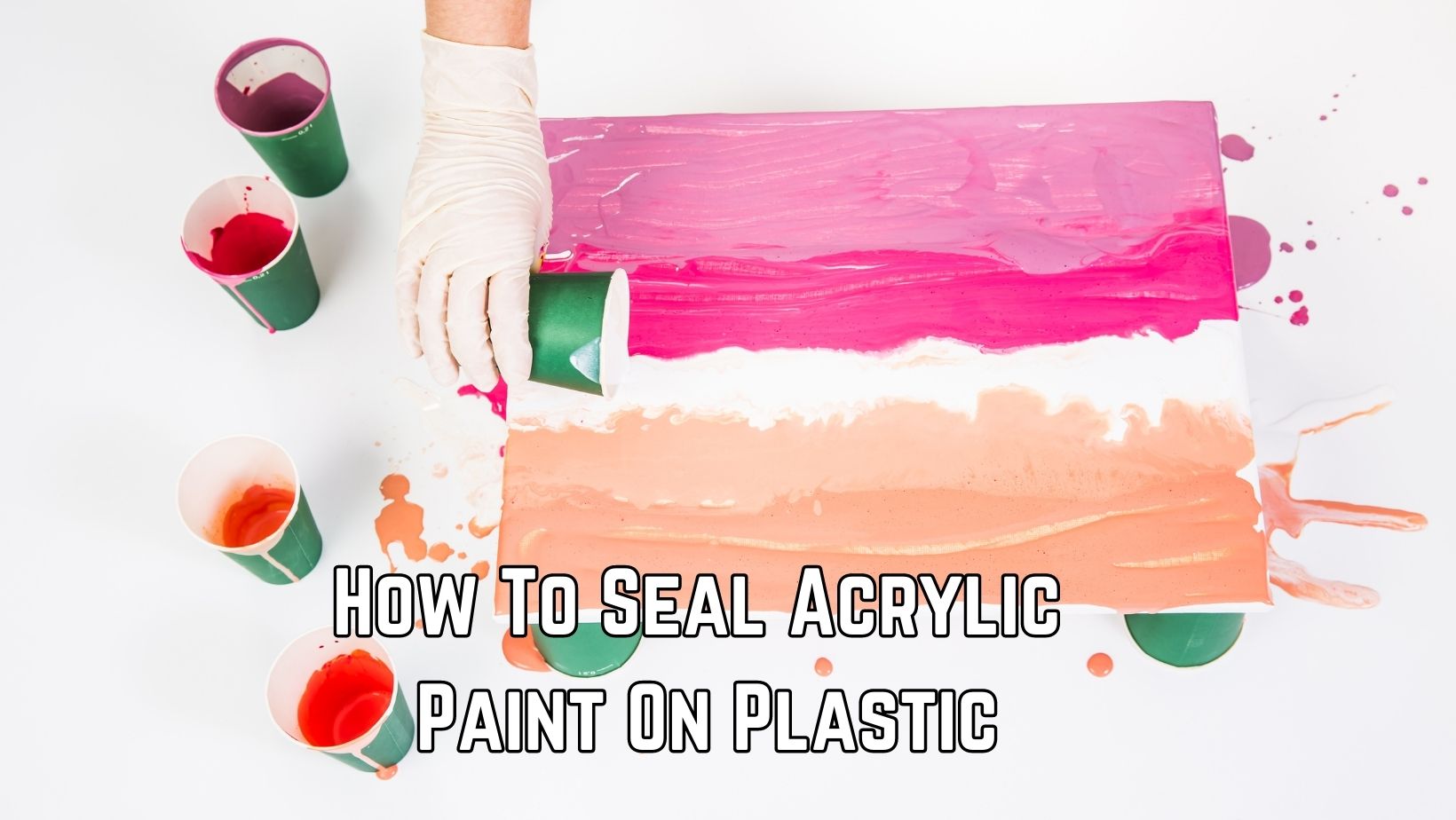
- Clean the plastic surface: Make sure the plastic surface is clean and free from any dirt or oil. You can use soap and water or rubbing alcohol to clean the surface. Let it dry completely.
- Apply a base coat: Apply a thin layer of gesso or primer to the plastic surface. This will help the acrylic paint adhere better to the plastic surface.
- Apply acrylic paint: Once the primer is dry, you can apply the acrylic paint to the plastic surface. Apply the paint in thin layers, allowing each layer to dry completely before applying the next layer.
- Let the paint dry: Let the paint dry completely before applying the sealant. This can take several hours or overnight.
- Apply sealant: Once the paint is completely dry, you can apply the sealant. You can use a clear acrylic sealer spray or brush-on sealant. Apply the sealant in thin layers, allowing each layer to dry completely before applying the next layer.
- Let the sealant dry: Let the sealant dry completely before handling the plastic surface. This can take several hours or overnight.
Following these steps will help ensure that the acrylic paint on plastic is properly sealed and protected.
Can You Use Acrylic Paint On Phone Case? Steps
Yes, you can use acrylic paint on a phone case. However, it is important to prepare the surface properly and seal the paint once it is dry to ensure that it adheres well and lasts long.
Here are the steps you can follow to use acrylic paint on a phone case:
- Clean the phone case: Use rubbing alcohol or soap and water to clean the phone case and remove any dirt, oils, or debris from the surface. Let it dry completely.
- Apply a base coat: To help the paint adhere better to the phone case, apply a thin layer of gesso or primer. Allow it to dry completely before painting.
- Apply acrylic paint: Apply acrylic paint to the phone case using a small brush or sponge. Apply thin layers, allowing each layer to dry before adding another layer. Be sure to use a paint that is suitable for plastic surfaces.
- Let the paint dry: Allow the paint to dry completely before handling the phone case. This can take several hours or overnight.
- Seal the paint: To protect the paint from chipping, peeling, or fading, use a clear acrylic sealer spray or brush-on sealant to seal the paint. Apply thin layers and let each layer dry completely before adding another layer.
By following these steps, you can use acrylic paint to customize your phone case and create a unique design that reflects your personal style.
Best Way To Seal Acrylic Paint On Plastic
Here are some tips to help you seal acrylic paint on plastic effectively:
- Choose a good quality sealant: Look for a clear acrylic sealant that is designed for use on plastic surfaces. Make sure it is non-toxic and safe for use on your specific type of plastic.
- Apply the sealant in thin layers: Use a light touch and apply the sealant in thin, even layers. This will help prevent drips and ensure a smooth finish. Be sure to let each layer dry completely before adding another layer.
- Use a spray for large surfaces: If you are sealing a large plastic surface, such as a toy or a piece of furniture, it may be more efficient to use a clear acrylic sealer spray. Make sure to use the spray in a well-ventilated area and follow the manufacturer’s instructions carefully.
- Consider using a gloss finish: If you want a shiny, glossy finish on your plastic surface, look for a clear acrylic sealer that provides a gloss finish. This will give your project a polished, professional look.
- Let the sealant dry completely: Once you have applied the final layer of sealant, let it dry completely. This can take several hours or overnight, depending on the type of sealant and the size of the surface.
Will Acrylic Paint Stick to Plastic?
Here are some tips to help acrylic paint adhere well to plastic surfaces:
- Clean the plastic surface: Before applying acrylic paint, clean the plastic surface thoroughly with soap and water or rubbing alcohol. This will remove any dirt, oil, or debris that could prevent the paint from sticking.
- Use a primer: Applying a thin layer of gesso or primer to the plastic surface can help the acrylic paint adhere better. The primer provides a slightly rough surface for the paint to adhere to, making it more durable and long-lasting.
- Choose the right paint: Not all acrylic paints are created equal, and some may not adhere well to plastic surfaces. Look for acrylic paint that is specifically formulated for use on plastic surfaces.
- Apply thin layers: When applying acrylic paint to plastic surfaces, it’s important to use thin layers. This will allow the paint to dry properly and adhere well. Avoid applying thick layers of paint, as they may peel or crack.
- Let the paint dry completely: Once you have applied the acrylic paint, let it dry completely before handling the plastic surface. This can take several hours or overnight, depending on the type of paint and the thickness of the layers.
Overall, with proper preparation and application techniques, acrylic paint can stick to plastic surfaces and create beautiful, long-lasting projects.
How do you keep acrylic paint from cracking on plastic?
- Clean the plastic surface: Make sure to clean the plastic surface thoroughly before painting. This will remove any dirt, oil, or debris that could affect the paint’s adhesion.
- Use a primer: Applying a thin layer of gesso or primer to the plastic surface can help the acrylic paint adhere better and prevent cracking.
- Choose the right paint: Look for acrylic paint that is specifically formulated for use on plastic surfaces. These paints are designed to be flexible and adhere well to plastic, reducing the risk of cracking.
- Apply thin layers: When applying acrylic paint to plastic surfaces, use thin layers rather than thick layers. This will allow the paint to dry evenly and flex with the plastic surface, reducing the risk of cracking.
- Seal the paint: Once the acrylic paint has dried completely, seal it with a clear acrylic sealer spray or brush-on sealant. This will protect the paint from moisture and temperature changes that can cause cracking.
By following these tips, you can help prevent acrylic paint from cracking on plastic surfaces and ensure that your project looks great and lasts long.
How do you permanently seal acrylic paint?
- Wait for the paint to dry completely: Before sealing the acrylic paint, make sure it has completely dried. Depending on the thickness of the paint layer, it may take several hours or even a day for the paint to dry completely.
- Choose the right sealer: Select a sealer that is appropriate for your project. Some sealers are specifically designed for indoor or outdoor use, while others are formulated to be heat-resistant, water-resistant, or UV-resistant.
- Apply the sealer: Use a brush or spray the sealer in thin, even layers, following the manufacturer’s instructions. Be sure to cover the entire painted surface to create a uniform and consistent finish.
- Let the sealer dry: Allow the sealer to dry completely between layers. Depending on the product, this may take several hours or overnight. Avoid touching or moving the painted object until the sealer is fully dry.
- Repeat the process: If you want extra protection or a thicker finish, you can repeat the sealing process by applying additional layers of the sealer.
By following these steps, you can permanently seal acrylic paint and protect it from fading, chipping, or peeling over time.

Hi Everyone, BeYoungAholic’s aim is to help women who have lost their self-confidence because of the way they look. We will provide you tips and bits of advice on how to take care of yourself and maintain your youthful look. So, Enjoy the blog!
